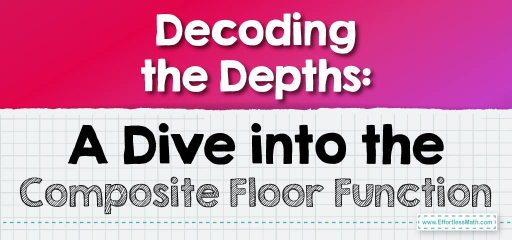Decoding the Depths: A Dive into the Composite Floor Function
The realm of mathematical functions houses various unique and intriguing functions. The floor function, often denoted by \(⌊ ⌋\), is a fascinating function that yields the largest integer less than or equal to a given number. Our discussion today encapsulates a composite floor function with parameters. Let’s dissect \(f(x)=a[g(x−b)]+k\) and unfurl its nuances.
[include_netrun_products_block from-products="product/6-south-carolina-sc-ready-grade-3-math-practice-tests/" product-list-class="bundle-products float-left" product-item-class="float-left" product-item-image-container-class="p-0 float-left" product-item-image-container-size="col-2" product-item-image-container-custom-style="" product-item-container-size="" product-item-add-to-cart-class="btn-accent btn-purchase-ajax" product-item-button-custom-url="{url}/?ajax-add-to-cart={id}" product-item-button-custom-url-if-not-salable="{productUrl} product-item-container-class="" product-item-element-order="image,title,purchase,price" product-item-title-size="" product-item-title-wrapper-size="col-10" product-item-title-tag="h3" product-item-title-class="mt-0" product-item-title-wrapper-class="float-left pr-0" product-item-price-size="" product-item-purchase-size="" product-item-purchase-wrapper-size="" product-item-price-wrapper-class="pr-0 float-left" product-item-price-wrapper-size="col-10" product-item-read-more-text="" product-item-add-to-cart-text="" product-item-add-to-cart-custom-attribute="title='Purchase this book with single click'" product-item-thumbnail-size="290-380" show-details="false" show-excerpt="false" paginate="false" lazy-load="true"]

Step-by-Step Guide to Understanding Floor Function
Here is a step-by-step guide to understand floor function:
Step 1: Foundational Pillars
- 1.1. Floor Function, \(⌊x⌋\): This gives the greatest integer less than or equal to x. For instance, \(⌊3.7⌋ = 3\), while \( ⌊-3.7⌋ = -4\).
- 1.2. Linear Transformation: A function of the form \(y=mx+c\), where ‘\(m\)’ and ‘\(c\)’ are constants, represents a straight line. In our composite function, the transformation \(g(x-b)\) can be seen as a shifted and/or scaled version of \(x\).
Step 2: Peeling Off The Layers of \(f(x)=a[g(x−b)]+k\)
- 2.1. Innermost Layer, \(g(x−b)\):
- The term \(x−b\) signifies a horizontal shift. If ‘\(b\)’ is positive, the graph moves to the right by ‘\(b\)’ units; otherwise, to the left.
- The function ‘\(g\)’ then acts upon this shifted ‘\(x\)’, which can stretch, compress, or flip the graph depending on its nature.
Original price was: $109.99.$54.99Current price is: $54.99. - 2.2. The Floor Encapsulation, \(⌊g(x-b)⌋\): Post the transformation of \(x−b\) by ‘\(g\)’, the floor function rounds the result down to the nearest integer.
- 2.3. Scaling and Vertical Shift:
- \(a[…]\): ‘\(a\)’ can stretch or compress the output vertically. If \(|a| > 1\), it stretches; if \(0 < |a| < 1\), it compresses. A negative ‘\(a\)’ will flip the graph upside-down.
- \(… + k\): This term vertically shifts the entire graph. A positive ‘\(k\)’ will move it up, and a negative ‘\(k\)’ will move it down.
Step 3: An Illustrative Example
Consider \(f(x)=2[3(x−1)]+1\).
- 3.1. Unpacking \(g(x−b)=3(x−1)\): Here, ‘\(b\)’ is \(1\), shifting the graph one unit right. The factor \(3\) stretches it vertically.
- 3.2. Applying the Floor: The function then rounds the values down, creating a step-like graph.
- 3.3. The Scaling and Shifting: Finally, multiply the values by \(2\) (stretching the steps) and shift one unit up.
Step 4: Observing the Effects on Graphs
To deeply understand the function’s behavior, graphing is instrumental. Sketching the transformations step-by-step can elucidate how each parameter influences the function.
Final Words
Our journey through the formula \(f(x)=a[g(x−b)]+k\) showcases the intricacies and depth inherent in mathematical functions. The combination of shifts, scalings, and the floor function’s unique properties culminate in a rich landscape of possible function graphs. Embracing each term’s effect in isolation, and then in combination, empowers us with a thorough grasp of this composite function.
Examples:
Example 1:
Given the function \(f(x)=3[2x+4]\), determine the value at \(x=1.25\).
Solution:
Plug \(1.25\) in the function equation and simplify. So, we have:
\(f(1.25)=3[2x+4]=3[2(1.25)+4]\)
\(3[2.5+4]=3[6.5]=3(6)=18\)
So, the answer is \(18\)
Example 2:
Given the function \(f(x)=[x+7]−4\), determine the value at \(x=−4.5\).
Solution:
Plug \(−4.5\) in the function equation and simplify. So, we have:
\(f(−4.5)=[x+7]-4=[(-4.5)+7]-4\)
\([(-4.5)+7]-4=[2.5]-4=(2)-4=-2\)
So, the answer is \(-2\)
Related to This Article
More math articles
- How to Solve a Quadratic Equation? (+FREE Worksheet!)
- 3rd Grade IAR Math FREE Sample Practice Questions
- Matching a Model with a Ratio
- Number Properties Puzzle -Critical Thinking 3
- FREE TABE Math Practice Test
- How to Unravel the Intricacies of Mathematical Relations: A Comprehensive Guide
- Double Digits, Double Fun: How to Solve Word Problems with Two-digit Divisors
- Full-Length PSAT 10 Math Practice Test
- 5 Best Smartphones for Math Teachers
- How to Model and Solve Equations Using Algebra Tiles





































What people say about "Decoding the Depths: A Dive into the Composite Floor Function - Effortless Math: We Help Students Learn to LOVE Mathematics"?
No one replied yet.